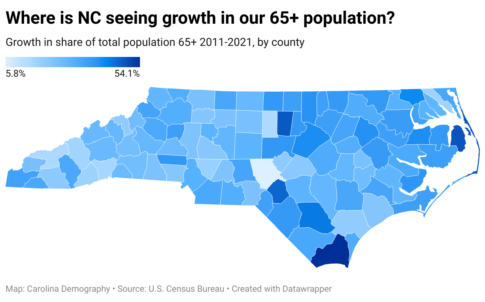NC’s senior population is growing, but where?

Baby Boomers — those born between 1946 and 1964 — started turning 65 in 2011. Since that time, over 100,000 North Carolinians have turned 65 each year and this trend will continue well into the future.
As Mike Cline noted in his look at NC’s population projects, the older adult population in North Carolina is expected to grow at double the rate of the overall population.. We can see this trend already taking place:
In other words, the population of 65+ (which also includes 85+) grew as a share of our total population when, over the same time period, other age groups take up a smaller piece of the pie compared to the previous time period. (An easy way to think about this is to consider North Carolina having 100 people total – in 2011, approximately 13 of those people would have been over 65. In 2022, that number rises to 17.)
If we look at population growth by age, we see a similar story. NC’s older populations are growing in number.
For example, our 65+ population grew by over 500,000 people between 2011 and 2021 (41%) while the 85+ population grew by almost 30,000 people (+16.9%). In comparison, the population under 65 grew by just about 11% in total, with the smallest growth (0.4%) taking place in the under-18 population.
Again, this is due to the large baby boomer population (those born between 1946 and 1964). In 2011, only baby boomers born in 1946 had turned 65, but by 2021 all older baby boomers (born 1946-1956) were 65 years old or older.
North Carolina is growing increasingly diverse, and we can see a more prominent shift to greater diversity at older ages. As population estimates by the State demographer’s office shows, it is estimated that by 2050, our population will be both more diverse and older.
From 2011 to 2021, all 100 counties across North Carolina saw growth in their shares of the population. The counties that experienced the largest population growth were Brunswick, Dare, and Orange where the share of 65+ populations increased by around 50% (54.1%, 49.0%, and 48.5%, respectively). On the lower end of the range, Moore, Alamance, and Swain counties experienced population growth in their population ages 65 and up that was smaller than 15% (5.8%, 14.4%, and 14.6%, respectively).
The share of the populations ages 85 (those born before 1937) and older did not increase across all 100 counties. In most counties, the share of the population aged 85 and up grew from 2011 to 2021. The range of positive population growth was larger than for the 65+ population, which includes this population. For the counties that experienced a positive population growth in the shares of the population 85 and older, the growth ranged from a 5% increase (Hertford, Montgomery, and Rutherford County) to a 164% increase (Gates County). In 12 counties, however, the share of the population aged 85 or older decreased from 2011 to 2021. The largest negative growth was experienced in Hyde County where the share of the population 85 or older decreased by 88%, followed by Jones County (-20.9%), and Clay County (-16.7%). Four counties experienced no change in their shares of the population 85 and over (Alamance, Anson, Green, and Orange.)
North Carolinians are living longer lives, which has implications on a broad range of policies, such as those that housing, land use, and emergency management. As our 65+ population increases, there will also be additional challenges for long-term support and healthcare services. For additional information, you can read:
Need help understanding population change and its impacts on your community or business? Carolina Demography offers demographic research tailored to your needs.
Contact us today for a free initial consultation.
Contact UsCategories: NC in Focus

The Center for Women’s Health Research (CWHR) at the University of North Carolina School of Medicine released the 12th edition of our North Carolina Women’s Health Report Card on May 9, 2022. This document is a progress report on the…

Dr. Krista Perreira is a health economist who studies disparities in health, education, and economic well-being. In collaboration with the Urban Institute, she recently co-led a study funded by the Kate B. Reynolds Foundation to study barriers to access to…

Our material helped the NC Local News Lab Fund better understand and then prioritize their funding to better serve existing and future grant recipients in North Carolina. The North Carolina Local News Lab Fund was established in 2017 to strengthen…
Your support is critical to our mission of measuring, understanding, and predicting population change and its impact. Donate to Carolina Demography today.